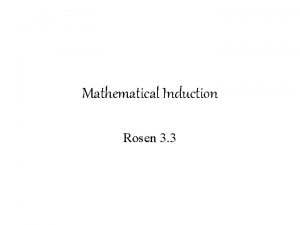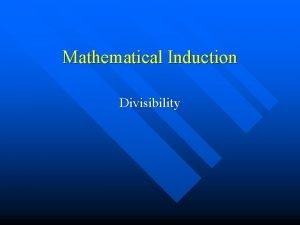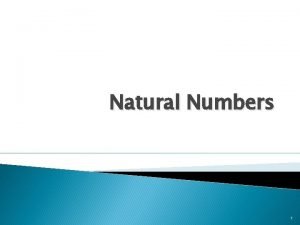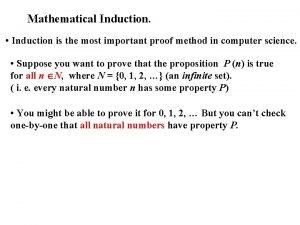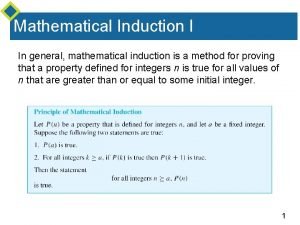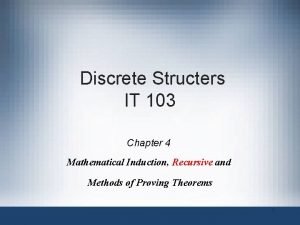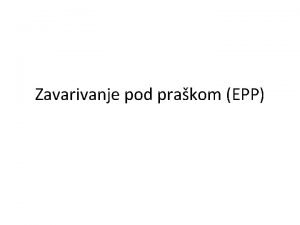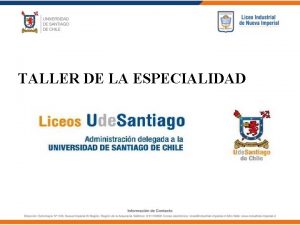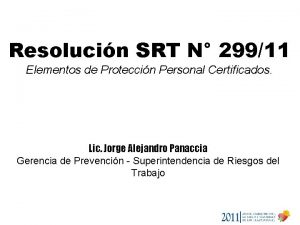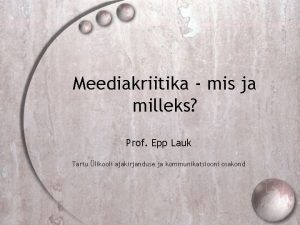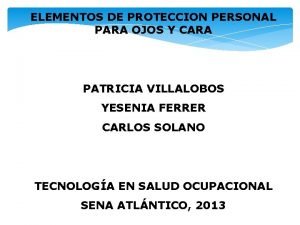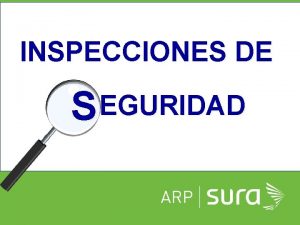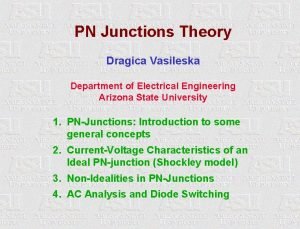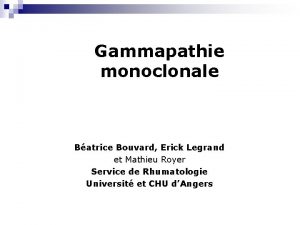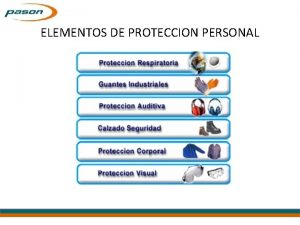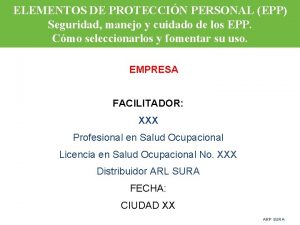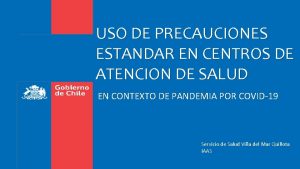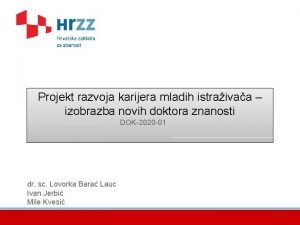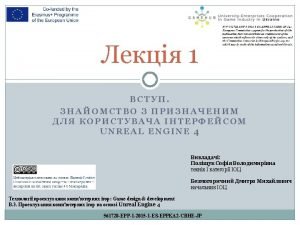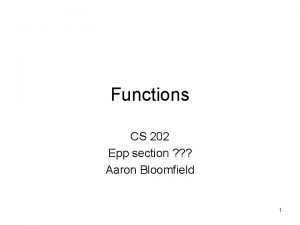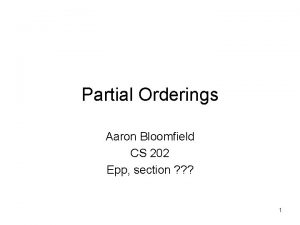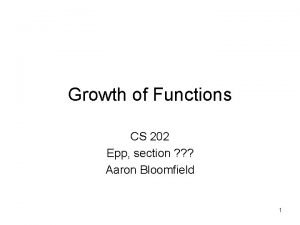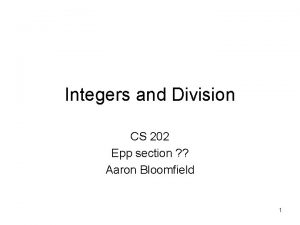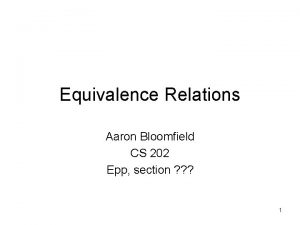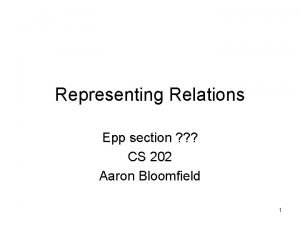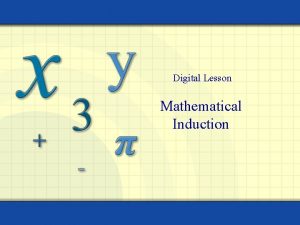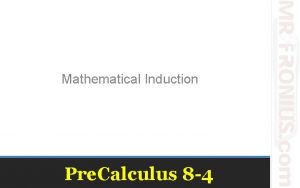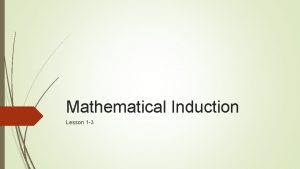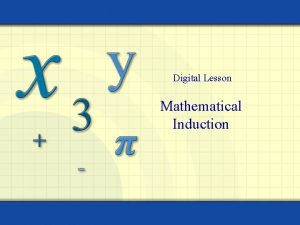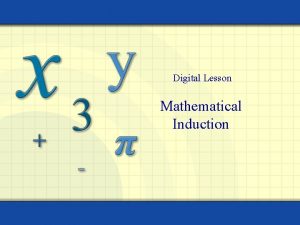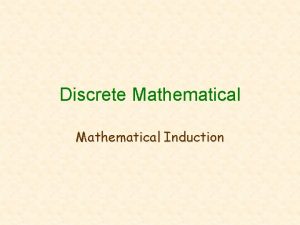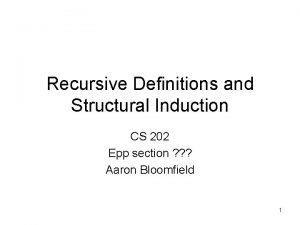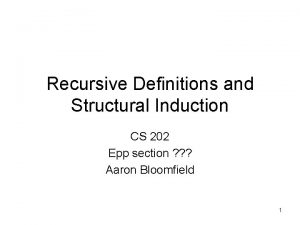Mathematical Induction CS 202 Epp chapter 4 Aaron


































- Slides: 34

Mathematical Induction CS 202 Epp, chapter 4 Aaron Bloomfield 1

How do you climb infinite stairs? • Not a rhetorical question! • First, you get to the base platform of the staircase • Then repeat: – From your current position, move one step up 2

Let’s use that as a proof method • First, show P(x) is true for x=0 – This is the base of the stairs • Then, show that if it’s true for some value n, then it is true for n+1 – – – – Show: P(n) P(n+1) This is climbing the stairs Let n=0. Since it’s true for P(0) (base case), it’s true for n=1 Let n=1. Since it’s true for P(1) (previous bullet), it’s true for n=2 Let n=2. Since it’s true for P(2) (previous bullet), it’s true for n=3 Let n=3 … And onwards to infinity • Thus, we have shown it to be true for all non-negative numbers 3

What is induction? • A method of proof • It does not generate answers: it only can prove them • Three parts: – Base case(s): show it is true for one element • (get to the stair’s base platform) – Inductive hypothesis: assume it is true for any given element • (assume you are on a stair) • Must be clearly labeled!!! – Show that if it true for the next highest element • (show you can move to the next stair) 4

Induction example • Show that the sum of the first n odd integers is n 2 – Example: If n = 5, 1+3+5+7+9 = 25 = 52 – Formally, show: • Base case: Show that P(1) is true 5

Induction example, continued • Inductive hypothesis: assume true for k – Thus, we assume that P(k) is true, or that – Note: we don’t yet know if this is true or not! • Inductive step: show true for k+1 – We want to show that: 6

Induction example, continued • Recall the inductive hypothesis: • Proof of inductive step: 7

What did we show • Base case: P(1) • If P(k) was true, then P(k+1) is true – i. e. , P(k) → P(k+1) • • • We know it’s true for P(1) Because of P(k) → P(k+1), if it’s true for P(1), then it’s true for P(2) Because of P(k) → P(k+1), if it’s true for P(2), then it’s true for P(3) Because of P(k) → P(k+1), if it’s true for P(3), then it’s true for P(4) Because of P(k) → P(k+1), if it’s true for P(4), then it’s true for P(5) And onwards to infinity • Thus, it is true for all possible values of n • In other words, we showed that: 8

The idea behind inductive proofs • Show the base case • Show the inductive hypothesis • Manipulate the inductive step so that you can substitute in part of the inductive hypothesis • Show the inductive step 9

Second induction example • Show the sum of the first n positive even integers is n 2 + n – Rephrased: • The three parts: – Base case – Inductive hypothesis – Inductive step 10

Second induction example, continued • Base case: Show P(1): • Inductive hypothesis: Assume • Inductive step: Show 11

Second induction example, continued • Recall our inductive hypothesis: 12

Notes on proofs by induction • We manipulate the k+1 case to make part of it look like the k case • We then replace that part with the other side of the k case 13

Third induction example • Show • Base case: n = 1 • Inductive hypothesis: assume 14

Third induction example • Inductive step: show 15

Third induction again: what if your inductive hypothesis was wrong? • Show: • Base case: n = 1: • But let’s continue anyway… • Inductive hypothesis: assume 16

Third induction again: what if your inductive hypothesis was wrong? • Inductive step: show 17

Fourth induction example • S that n! < nn for all n > 1 • Base case: n = 2 2! < 22 2<4 • Inductive hypothesis: assume k! < kk • Inductive step: show that (k+1)! < (k+1)k+1 18

Strong induction • Weak mathematical induction assumes P(k) is true, and uses that (and only that!) to show P(k+1) is true • Strong mathematical induction assumes P(1), P(2), …, P(k) are all true, and uses that to show that P(k+1) is true. 19

Strong induction example 1 • Show that any number > 1 can be written as the product of one or more primes • Base case: P(2) – 2 is the product of 2 (remember that 1 is not prime!) • Inductive hypothesis: assume P(2), P(3), …, P(k) are all true • Inductive step: Show that P(k+1) is true 20

Strong induction example 1 • Inductive step: Show that P(k+1) is true • There are two cases: – k+1 is prime • It can then be written as the product of k+1 – k+1 is composite • It can be written as the product of two composites, a and b, where 2 ≤ a ≤ b < k+1 • By the inductive hypothesis, both P(a) and P(b) are true 21

Strong induction vs. non-strong induction • Determine which amounts of postage can be written with 5 and 6 cent stamps – Prove using both versions of induction • Answer: any postage ≥ 20 22

Answer via mathematical induction • Show base case: P(20): – 20 = 5 + 5 + 5 • Inductive hypothesis: Assume P(k) is true • Inductive step: Show that P(k+1) is true – If P(k) uses a 5 cent stamp, replace that stamp with a 6 cent stamp – If P(k) does not use a 5 cent stamp, it must use only 6 cent stamps • Since k > 18, there must be four 6 cent stamps • Replace these with five 5 cent stamps to obtain k+1 23

Answer via strong induction • Show base cases: P(20), P(21), P(22), P(23), and P(24) – 20 = 5 + 5 + 5 – 21 = 5 + 5 + 6 – 22 = 5 + 6 + 6 – 23 = 5 + 6 + 6 – 24 = 6 + 6 + 6 • Inductive hypothesis: Assume P(20), P(21), …, P(k) are all true • Inductive step: Show that P(k+1) is true – We will obtain P(k+1) by adding a 5 cent stamp to P(k+1 -5) – Since we know P(k+1 -5) = P(k-4) is true, our proof is complete 24

Strong induction vs. non-strong induction, take 2 • Show that every postage amount 12 cents or more can be formed using only 4 and 5 cent stamps • Similar to the previous example 25

Answer via mathematical induction • Show base case: P(12): – 12 = 4 + 4 • Inductive hypothesis: Assume P(k) is true • Inductive step: Show that P(k+1) is true – If P(k) uses a 4 cent stamp, replace that stamp with a 5 cent stamp to obtain P(k+1) – If P(k) does not use a 4 cent stamp, it must use only 5 cent stamps • Since k > 10, there must be at least three 5 cent stamps • Replace these with four 4 cent stamps to obtain k+1 • Note that only P(k) was assumed to be true 26

Answer via strong induction • Show base cases: P(12), P(13), P(14), and P(15) – 12 = 4 + 4 – 13 = 4 + 5 – 14 = 4 + 5 – 15 = 5 + 5 • Inductive hypothesis: Assume P(12), P(13), …, P(k) are all true – For k ≥ 15 • Inductive step: Show that P(k+1) is true – We will obtain P(k+1) by adding a 4 cent stamp to P(k+1 -4) – Since we know P(k+1 -4) = P(k-3) is true, our proof is complete • Note that P(12), P(13), …, P(k) were all assumed to be true 27

Chess and induction Can the knight reach any square in a finite number of moves? 7 6 5 Show that the knight can reach any square (i, j) for which i+j=k where k > 1. 4 Base case: k = 2 3 Inductive hypothesis: assume the knight can reach any square (i, j) for which i+j=k where k > 1. 2 Inductive step: show the knight can reach any square (i, j) for which i+j=k+1 where k > 1. 1 0 28 0 1 2 3 4 5 6 7

Chess and induction • Inductive step: show the knight can reach any square (i, j) for which i+j=k+1 where k > 1. – Note that k+1 ≥ 3, and one of i or j is ≥ 2 – If i ≥ 2, the knight could have moved from (i-2, j+1) • Since i+j = k+1, i-2 + j+1 = k, which is assumed true – If j ≥ 2, the knight could have moved from (i+1, j-2) • Since i+j = k+1, i+1 + j-2 = k, which is assumed true 29

Inducting stones • Take a pile of n stones – Split the pile into two smaller piles of size r and s – Repeat until you have n piles of 1 stone each • Take the product of all the splits – So all the r’s and s’s from each split • Sum up each of these products • Prove that this product equals 30

Inducting stones 10 21 12 2 4 1 2 1 1 1 31

Inducting stones • We will show it is true for a pile of k stones, and show it is true for k+1 stones – So P(k) means that it is true for k stones • Base case: n = 1 – No splits necessary, so the sum of the products = 0 – 1*(1 -1)/2 = 0 – Base case proven 32

Inducting stones • Inductive hypothesis: assume that P(1), P(2), …, P(k) are all true – This is strong induction! • Inductive step: Show that P(k+1) is true – We assume that we split the k+1 pile into a pile of i stones and a pile of k+1 -i stones – Thus, we want to show that (i)*(k+1 -i) + P(k+1 -i) = P(k+1) – Since 0 < i < k+1, both i and k+1 -i are between 1 and k, inclusive 33

Inducting stones Thus, we want to show that (i)*(k+1 -i) + P(k+1 -i) = P(k+1) 34
 Strong induction
Strong induction Induction math
Induction math Mathematical induction divisibility
Mathematical induction divisibility Mathematical induction ppt
Mathematical induction ppt Mathematical induction
Mathematical induction Proof by mathematical induction
Proof by mathematical induction Mathematical induction
Mathematical induction Mathematical induction
Mathematical induction Geometric sequence closed form
Geometric sequence closed form Principle of mathematical induction
Principle of mathematical induction Induksi matematika
Induksi matematika What is mathematical economics
What is mathematical economics Epp zavarivanje
Epp zavarivanje Epp de un soldador
Epp de un soldador Susanna s epp
Susanna s epp Elementos de proteccion personal srt
Elementos de proteccion personal srt Epp lauk
Epp lauk Capote de bombero
Capote de bombero Elementos de proteccion personal para los ojos
Elementos de proteccion personal para los ojos Formato de inspección de epp sura
Formato de inspección de epp sura Cdw employee purchase program
Cdw employee purchase program Dragica vasileska
Dragica vasileska Ngb form 4100
Ngb form 4100 Bloc beta gamma epp
Bloc beta gamma epp Objetivo de epp
Objetivo de epp Riesgos mecanicos
Riesgos mecanicos Imagen uso de epp
Imagen uso de epp Paycheck8 usda
Paycheck8 usda Hrzz epp
Hrzz epp Satya shanbhag
Satya shanbhag Eppka
Eppka Definicion de epp
Definicion de epp Cranfield school of management
Cranfield school of management Bp form 202-a
Bp form 202-a Profile milling
Profile milling
